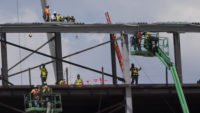Construction began earlier this year on a 54-story tower in Jersey City, part of a planned three-tower, 2.3-million-sq-ft "Journal Squared" development site. Plans for the five-year project in the Journal Square area of the city include a 70-story building, which is expected to be the state's tallest residential tower, and a 60-story high-rise.
Other high-growth areas in the state include the higher education sector, according to Monaco. "Montclair, Rutgers, Stevens Institute, nearly all of the major colleges and universities are making sizable investments," he says.
"The other big piece for some of our members is energy infrastructure," Monaco says. He notes significant work from utilities PSE&G and Jersey Central Power & Light "to improve the infrastructure in response to Sandy," adding that most of it calls for involvement of the electrical trades.
Under PSE&G's $1.2-billion Energy Strong program created in the wake of Sandy to strengthen infrastructure against severe weather damage, the utility has already begun replacing gas mains in several New Jersey towns.
Despite growth in such sectors as education and energy, other markets are lagging, Monaco says. "Some of the data center and solar work has run its course and is not to the same degree that it was a few years ago."
Monaco says that, overall, participants in the New Jersey subcontracting market remain cautiously optimistic. "Last year and this were similar to the prior year," he says. "We're starting to pull out of the recessionary environment, starting to see people talking about new investments but certainly not ramping up with hiring or anything like that."
In New York, however, "trade employment is coming up," EMCOR's Guzzi says. Given the amount of mega-projects and other work under way or about to start in the metro region, "it's a fairly healthy market compared to where it was [two years ago]." While the construction industry is still not where it was before the recession, he says, "it's moving in that direction."









